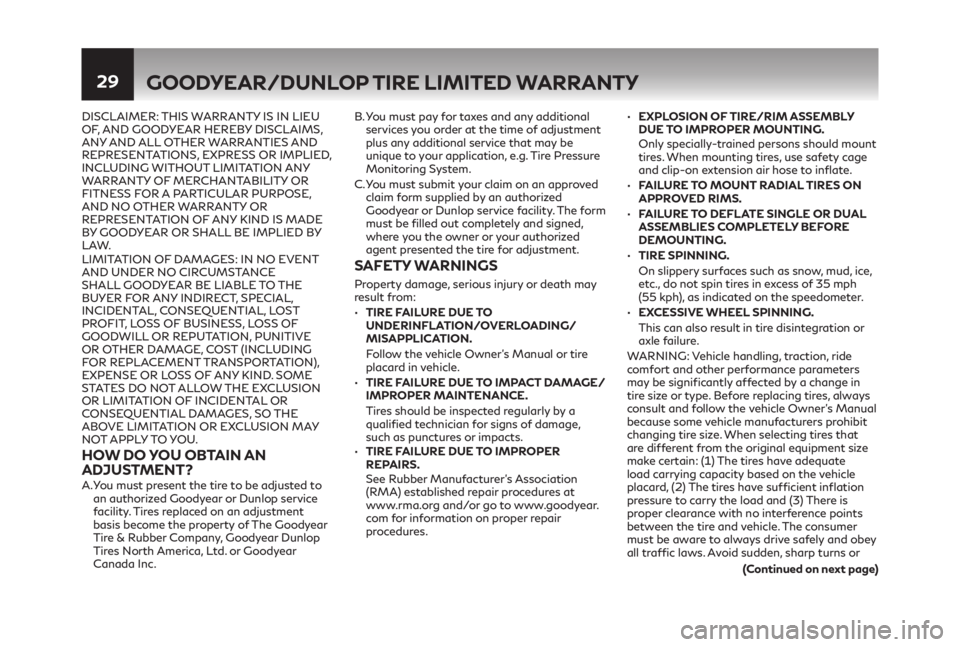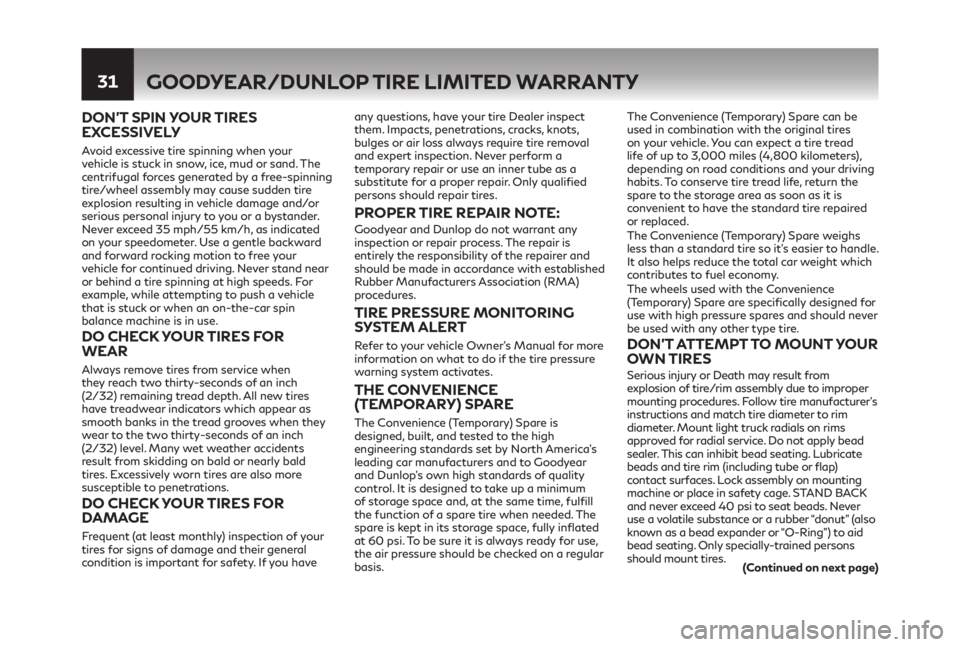rims INFINITI Q50 2021 Warranty Information Booklet
[x] Cancel search | Manufacturer: INFINITI, Model Year: 2021, Model line: Q50, Model: INFINITI Q50 2021Pages: 54, PDF Size: 0.34 MB
Page 32 of 54

29
DISCLAIMER: THIS WARRANTY IS IN LIEU
OF, AND GOODYEAR HEREBY DISCLAIMS,
ANY AND ALL OTHER WARRANTIES AND
REPRESENTATIONS, EXPRESS OR IMPLIED,
INCLUDING WITHOUT LIMITATION ANY
WARRANTY OF MERCHANTABILITY OR
FITNESS FOR A PARTICULAR PURPOSE,
AND NO OTHER WARRANTY OR
REPRESENTATION OF ANY KIND IS MADE
BY GOODYEAR OR SHALL BE IMPLIED BY
L AW.
LIMITATION OF DAMAGES: IN NO EVENT
AND UNDER NO CIRCUMSTANCE
SHALL GOODYEAR BE LIABLE TO THE
BUYER FOR ANY INDIRECT, SPECIAL,
INCIDENTAL, CONSEQUENTIAL, LOST
PROFIT, LOSS OF BUSINESS, LOSS OF
GOODWILL OR REPUTATION, PUNITIVE
OR OTHER DAMAGE, COST (INCLUDING
FOR REPLACEMENT TRANSPORTATION),
EXPENSE OR LOSS OF ANY KIND. SOME
STATES DO NOT ALLOW THE EXCLUSION
OR LIMITATION OF INCIDENTAL OR
CONSEQUENTIAL DAMAGES, SO THE
ABOVE LIMITATION OR EXCLUSION MAY
NOT APPLY TO YOU.
HOW DO YOU OBTAIN AN
ADJUSTMENT?
A. You must present the tire to be adjusted to
an authorized Goodyear or Dunlop service
facility. Tires replaced on an adjustment
basis become the property of The Goodyear
Tire & Rubber Company, Goodyear Dunlop
Tires North America, Ltd. or Goodyear
Canada Inc. B.
You must pay for taxes and any additional
services you order at the time of adjustment
plus any additional service that may be
unique to your application, e.g. Tire Pressure
Monitoring System.
C. You must submit your claim on an approved
claim form supplied by an authorized
Goodyear or Dunlop service facility. The form
must be filled out completely and signed,
where you the owner or your authorized
agent presented the tire for adjustment.
SAFETY WARNINGS
Property damage, serious injury or death may
result from:
•• TIRE FAILURE DUE TO
UNDERINFLATION/OVERLOADING/
MISAPPLICATION.
Follow the vehicle Owner’s Manual or tire
placard in vehicle.
•• TIRE FAILURE DUE TO IMPACT DAMAGE/
IMPROPER MAINTENANCE.
Tires should be inspected regularly by a
qualified technician for signs of damage,
such as punctures or impacts.
•• TIRE FAILURE DUE TO IMPROPER
REPAIRS.
See Rubber Manufacturer’s Association
(RMA) established repair procedures at
www.rma.org and/or go to www.goodyear.
com for information on proper repair
procedures.
•• EXPLOSION OF TIRE/RIM ASSEMBLY
DUE TO IMPROPER MOUNTING.
Only specially-trained persons should mount
tires. When mounting tires, use safety cage
and clip-on extension air hose to inflate.
•• FAILURE TO MOUNT RADIAL TIRES ON
APPROVED RIMS.
•• FAILURE TO DEFLATE SINGLE OR DUAL
ASSEMBLIES COMPLETELY BEFORE
DEMOUNTING.
•• TIRE SPINNING.
On slippery surfaces such as snow, mud, ice,
etc., do not spin tires in excess of 35 mph
(55 kph), as indicated on the speedometer.
•• EXCESSIVE WHEEL SPINNING.
This can also result in tire disintegration or
axle failure.
WARNING: Vehicle handling, traction, ride
comfort and other performance parameters
may be significantly affected by a change in
tire size or type. Before replacing tires, always
consult and follow the vehicle Owner’s Manual
because some vehicle manufacturers prohibit
changing tire size. When selecting tires that
are different from the original equipment size
make certain: (1) The tires have adequate
load carrying capacity based on the vehicle
placard, (2) The tires have sufficient inflation
pressure to carry the load and (3) There is
proper clearance with no interference points
between the tire and vehicle. The consumer
must be aware to always drive safely and obey
all traffic laws. Avoid sudden, sharp turns or
GOODYEAR/DUNLOP TIRE LIMITED WARRANTY
(Continued on next page)
4303458_21a_INFINITI_US_WIB_032520.indd 294303458_21a_INFINITI_US_WIB_032520.indd 294/8/2020 10:18:18 AM4/8/2020 10:18:18 AM
Page 34 of 54

31
DON’T SPIN YOUR TIRES
EXCESSIVELY
Avoid excessive tire spinning when your
vehicle is stuck in snow, ice, mud or sand. The
centrifugal forces generated by a free-spinning
tire/wheel assembly may cause sudden tire
explosion resulting in vehicle damage and/or
serious personal injury to you or a bystander.
Never exceed 35 mph/55 km/h, as indicated
on your speedometer. Use a gentle backward
and forward rocking motion to free your
vehicle for continued driving. Never stand near
or behind a tire spinning at high speeds. For
example, while attempting to push a vehicle
that is stuck or when an on-the-car spin
balance machine is in use.
DO CHECK YOUR TIRES FOR
WEAR
Always remove tires from service when
they reach two thirty-seconds of an inch
(2/32) remaining tread depth. All new tires
have treadwear indicators which appear as
smooth banks in the tread grooves when they
wear to the two thirty-seconds of an inch
(2/32) level. Many wet weather accidents
result from skidding on bald or nearly bald
tires. Excessively worn tires are also more
susceptible to penetrations.
DO CHECK YOUR TIRES FOR
DAMAGE
Frequent (at least monthly) inspection of your
tires for signs of damage and their general
condition is important for safety. If you have any questions, have your tire Dealer inspect
them. Impacts, penetrations, cracks, knots,
bulges or air loss always require tire removal
and expert inspection. Never perform a
temporary repair or use an inner tube as a
substitute for a proper repair. Only qualified
persons should repair tires.
PROPER TIRE REPAIR NOTE:
Goodyear and Dunlop do not warrant any
inspection or repair process. The repair is
entirely the responsibility of the repairer and
should be made in accordance with established
Rubber Manufacturers Association (RMA)
procedures.
TIRE PRESSURE MONITORING
SYSTEM ALERT
Refer to your vehicle Owner’s Manual for more
information on what to do if the tire pressure
warning system activates.
THE CONVENIENCE
(TEMPORARY) SPARE
The Convenience (Temporary) Spare is
designed, built, and tested to the high
engineering standards set by North America’s
leading car manufacturers and to Goodyear
and Dunlop’s own high standards of quality
control. It is designed to take up a minimum
of storage space and, at the same time, fulfill
the function of a spare tire when needed. The
spare is kept in its storage space, fully inflated
at 60 psi. To be sure it is always ready for use,
the air pressure should be checked on a regular
basis. The Convenience (Temporary) Spare can be
used in combination with the original tires
on your vehicle. You can expect a tire tread
life of up to 3,000 miles (4,800 kilometers),
depending on road conditions and your driving
habits. To conserve tire tread life, return the
spare to the storage area as soon as it is
convenient to have the standard tire repaired
or replaced.
The Convenience (Temporary) Spare weighs
less than a standard tire so it’s easier to handle.
It also helps reduce the total car weight which
contributes to fuel economy.
The wheels used with the Convenience
(Temporary) Spare are specifically designed for
use with high pressure spares and should never
be used with any other type tire.
DON’T ATTEMPT TO MOUNT YOUR
OWN TIRES
Serious injury or Death may result from
explosion of tire/rim assembly due to improper
mounting procedures. Follow tire manufacturer’s
instructions and match tire diameter to rim
diameter. Mount light truck radials on rims
approved for radial service. Do not apply bead
sealer. This can inhibit bead seating. Lubricate
beads and tire rim (including tube or flap)
contact surfaces. Lock assembly on mounting
machine or place in safety cage. STAND BACK
and never exceed 40 psi to seat beads. Never
use a volatile substance or a rubber “donut” (also
known as a bead expander or “O-Ring”) to aid
bead seating. Only specially-trained persons
should mount tires.
GOODYEAR/DUNLOP TIRE LIMITED WARRANTY
(Continued on next page)
4303458_21a_INFINITI_US_WIB_032520.indd 314303458_21a_INFINITI_US_WIB_032520.indd 314/8/2020 10:18:18 AM4/8/2020 10:18:18 AM
Page 46 of 54

43
Contact the manufacturer of your tires for
their position and assistance on the repair of
speed-rated tires. When you are replacing tires
that have a speed rating, you must replace
with tires of the same or higher speed rating
if the speed capability of the vehicle is to be
maintained.
VISUAL INSPECTION
INSPECT YOUR TIRES. DO NOT DRIVE ON A
DAMAGED TIRE OR WHEEL. Check your tires
frequently for scrapes, bulges, separations,
cuts, snags, cracks, penetrations or excessive
localized wear from hard braking. Also check
for abnormal tire wear, particularly on the
edges of the tire tread which may be caused
by misalignment or underinflation. Impacts
can damage the inner portion of the tire
without being visible on the outside. If damage
can be seen on the tires or wheels, or if you
suspect that possible impact damage may
have occurred, replace with spare at once and
have your tire store or retailer inspect your
tires immediately. Use of a damaged tire could
result in tire destruction. When inspecting
your tires, including the spare, check your air
pressures. If your pressure check indicates
that one of your tires has lost pressure of two
pounds or more, look for signs of penetrations,
valve leakage, or wheel damage that may
account for the air loss. All tires will wear out faster when subjected
to high speeds as well as hard cornering, rapid
starts, sudden stops, frequent driving on roads
which are in poor condition, and off-road use.
Roads with holes and rocks or other objects
can damage tires and cause misalignment of
your vehicle. When you drive on such roads,
drive on them carefully and slowly, and before
driving again at normal or highway speeds,
examine your tires for any damage, such
as cuts, bulges, penetrations, unusual wear
patterns, etc.
TREAD WEAR INDICATORS (WEAR BARS):
Tires contain Tread Wear Indicators (Wear
Bars) in the grooves of the tire tread which
show up when only 2/32nds of an inch
(1.6mm) of tread is remaining. At this stage,
your tires must be replaced. Tires worn beyond
this stage are dangerous.
HAZARDS
Objects in the road that threaten a tire should
be safely avoided. These objects are potholes,
glass, metal, rocks, wood debris and the
like. Unavoidable contact should prompt a
thorough tire inspection.
You may not always recall hitting an object
that can damage or injure your tires. If while
driving your vehicle experiences any unusual
vibrations, ride disturbance or noise and/or you
suspect that possible damage to the tires or
vehicle has occurred, DO NOT JAM OR LOCK
YOUR BRAKES! Rather reduce your speed and
drive with caution until you can safely pull off
the road. Stop and inspect the tires. If the tire is underinflated or damaged, deflate, remove
the tire and rim assembly and replace it with
your spare. If you cannot detect a cause, have
the vehicle towed to the nearest vehicle or tire
retailer to have the vehicle inspected.
REPAIRING, MOUNTING AND
DEMOUNTING OF TIRES
Do not attempt to repair, mount or demount a
tire yourself. Tire changing can be dangerous
and must be done by professionally trained
persons using proper tools and procedures
as specified by the Rubber Manufacturers
Association (RMA). Follow these mounting
recommendations. Your tires should be
mounted on wheels of correct size and type
and which are in good, clean condition. Bent,
chipped or rusted wheels may cause tire
damage. The inside of the tire must be free
from foreign materials. Have your retailer
check the wheels before mounting new tires.
Mismatched tires and rims can explode during
mounting. Also, mismatched tires and rims can
result in dangerous tire failure on the road. If
a tire is mounted by error on the wrong-sized
rim, do not remount it on the proper rim -
scrap it. It may be damaged internally (which
is not externally visible) by being dangerously
stretched and could fail on the highway.
Old valves may leak. When new tubeless tires
are mounted, have new valves of the correct
type installed. Tubeless tires must be mounted
only on wheels designed for tubeless tires, i.e.,
wheels which have safety humps or ledges.
IMPORTANT TIRE SAFETY INFORMATION¹
(Continued on next page)
4303458_21a_INFINITI_US_WIB_032520.indd 434303458_21a_INFINITI_US_WIB_032520.indd 434/8/2020 10:18:18 AM4/8/2020 10:18:18 AM